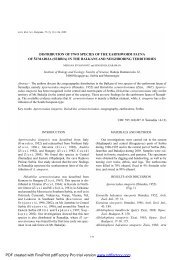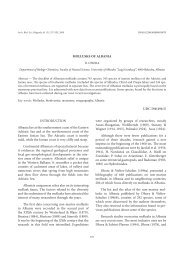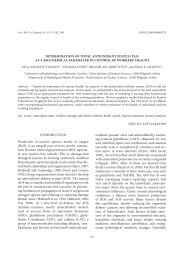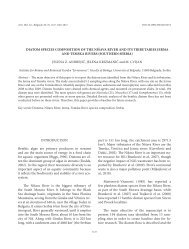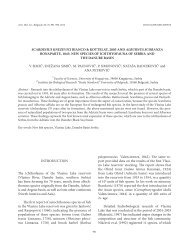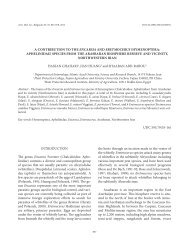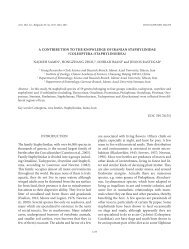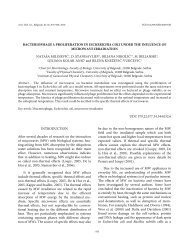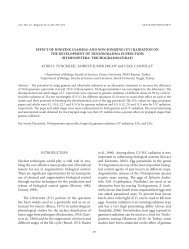Stages of flower bud development in Iris pumila and between ...
Stages of flower bud development in Iris pumila and between ...
Stages of flower bud development in Iris pumila and between ...
Create successful ePaper yourself
Turn your PDF publications into a flip-book with our unique Google optimized e-Paper software.
Arch. Biol. Sci., Belgrade, 64 (1), 77-83, 2012 DOI:10.2298/ABS1201077L<br />
STAGES OF FLOWER BUD DEVELOPMENT IN IRIS PUMILA AND<br />
BETWEEN-HABITAT MORPHOLOGICAL DIFFERENCES<br />
NATAŠA BARIŠIĆ KLISARIĆ, DANIJELA MILJKOVIĆ, S. AVRAMOV,<br />
U. ŽIVKOVIĆ <strong>and</strong> A. TARASJEV<br />
Institute for Biological Research, “S<strong>in</strong>iša Stanković”, University <strong>of</strong> Belgrade, 11000 Belgrade, Serbia<br />
Abstract - Previous studies revealed significant phenotypic plasticity <strong>and</strong> <strong>between</strong>-population differentiation <strong>in</strong> <strong>flower</strong><br />
morphometric traits <strong>of</strong> <strong>Iris</strong> <strong>pumila</strong> <strong>in</strong> response to environmental variability <strong>between</strong> natural shade <strong>and</strong> exposed habitats.<br />
S<strong>in</strong>ce these habitats differed <strong>in</strong> <strong>flower</strong><strong>in</strong>g times as well, <strong>in</strong> this work we <strong>in</strong>vestigated at which stages <strong>of</strong> <strong>flower</strong> <strong>bud</strong> <strong>development</strong><br />
differences <strong>between</strong> open <strong>and</strong> shaded habitats start to appear. Our analysis detected several groups <strong>of</strong> trait <strong>development</strong><br />
patterns through the I. <strong>pumila</strong> <strong>bud</strong> <strong>development</strong> <strong>in</strong> two contrast<strong>in</strong>g habitats, with stem length be<strong>in</strong>g the most suitable<br />
trait for application <strong>in</strong> further analyses <strong>of</strong> so-called “shade avoidance syndrome”.<br />
Key words: Phenotypic plasticity, <strong>between</strong>-population differentiation, “shade avoidance syndrome”, <strong>flower</strong> morphometric<br />
traits, stage allometry, <strong>Iris</strong> <strong>pumila</strong><br />
INTRODUCTION<br />
The evolution <strong>of</strong> adaptation depends not only on<br />
the genetic variation that leads to <strong>between</strong>-population<br />
differentiation for the traits <strong>in</strong> question, but<br />
also on their phenotypic plasticity (Schlicht<strong>in</strong>g <strong>and</strong><br />
Pigliucci, 1998; Pigliucci, 2001; de Jong, 2005). Previous<br />
studies <strong>of</strong> <strong>Iris</strong> <strong>pumila</strong> <strong>flower</strong> morphometric<br />
traits <strong>in</strong> natural habitats detected significant environmental<br />
heteroscedascity (Tucić et al., 1990) <strong>and</strong><br />
revealed both significant plastic responses as well as<br />
<strong>between</strong>-population differentiation <strong>between</strong> shaded<br />
<strong>and</strong> open habitats (Tarasjev et al., 2009). Plasticity<br />
<strong>and</strong> differentiation were mostly consistent with<br />
responses expected <strong>in</strong> the case <strong>of</strong> so called “shade<br />
avoidance syndrome” (Schmitt <strong>and</strong> Wulff, 1993; Von<br />
Wettberg, et al., 2008; McGoey <strong>and</strong> St<strong>in</strong>chcombe,<br />
2009; Tarasjev et al., 2009). On the other h<strong>and</strong>, the<br />
study <strong>of</strong> I. <strong>pumila</strong> phenology revealed similar significant<br />
phenotypic plasticity as well as population<br />
differentiation <strong>in</strong> the <strong>flower</strong><strong>in</strong>g time <strong>of</strong> populations<br />
77<br />
occupy<strong>in</strong>g the same contrast<strong>in</strong>g habitats (Tarasjev,<br />
1997). The possible <strong>in</strong>fluence <strong>of</strong> <strong>flower</strong><strong>in</strong>g time on<br />
detected differences <strong>in</strong> <strong>flower</strong> morphometric traits<br />
<strong>in</strong> previous studies must also be exam<strong>in</strong>ed. To approach<br />
this relationship, the ontogenic aspect must<br />
be covered s<strong>in</strong>ce plasticity <strong>in</strong> plants can be the result<br />
<strong>of</strong> the direct response <strong>of</strong> a trait to environmental<br />
cues dur<strong>in</strong>g <strong>development</strong>, or a passive result <strong>of</strong><br />
changes <strong>in</strong> the plant growth rate due to various factors<br />
(Schlicht<strong>in</strong>g <strong>and</strong> Pigliucci, 1998; Wright <strong>and</strong><br />
McConnaughay, 2002; Var<strong>in</strong> et al., 2009), with the<br />
phenological response <strong>in</strong>fluenc<strong>in</strong>g other traits be<strong>in</strong>g<br />
a significant one (Diggle, 1999; Forrest <strong>and</strong> Miller-<br />
Rush<strong>in</strong>g, 2010). Previous studies <strong>of</strong> the <strong>flower</strong> <strong>bud</strong>s<br />
<strong>in</strong> populations from open <strong>and</strong> shaded habitats, but<br />
performed at different time po<strong>in</strong>ts (Barišić Klisarić<br />
et al., 2011), revealed that stem length was the only<br />
trait that showed higher values <strong>in</strong> shaded habitats<br />
for the very beg<strong>in</strong>n<strong>in</strong>g. Most <strong>of</strong> the other traits had<br />
higher values <strong>in</strong> the <strong>bud</strong> stage <strong>in</strong> habitats that will<br />
<strong>flower</strong> earlier (open habitats) compared to habitats
78 NATAŠA BARIŠIĆ KLISARIĆ ET AL.<br />
that have higher values for open <strong>flower</strong>s (shaded).<br />
To supplement the analysis <strong>of</strong> the <strong>flower</strong>’s morphometric<br />
traits at the same time periods, we studied<br />
the morphometric traits <strong>in</strong> the same stages <strong>of</strong> <strong>flower</strong><br />
<strong>bud</strong> <strong>development</strong>.<br />
The goals <strong>of</strong> this study were to analyze the morphometric<br />
<strong>flower</strong> traits at different stages <strong>of</strong> <strong>flower</strong><br />
ontogeny (stage allometry) on naturally grow<strong>in</strong>g<br />
clones <strong>of</strong> I. <strong>pumila</strong> occupy<strong>in</strong>g contrast<strong>in</strong>g light habitats<br />
(open vs. shaded) <strong>in</strong> order to: analyze traits at<br />
different stages dur<strong>in</strong>g the <strong>flower</strong> <strong>bud</strong> ontogenetic<br />
<strong>development</strong> <strong>and</strong> detect the stages at which the<br />
growth <strong>of</strong> certa<strong>in</strong> <strong>flower</strong> parts occurs; analyze traits<br />
at different stages dur<strong>in</strong>g the <strong>flower</strong> <strong>bud</strong> ontogenetic<br />
<strong>development</strong> <strong>and</strong> to detect the stages at which<br />
differences <strong>between</strong> habitats <strong>in</strong> the size <strong>of</strong> certa<strong>in</strong><br />
<strong>flower</strong> parts occur, <strong>and</strong> to compare the detected<br />
differences <strong>in</strong> the <strong>flower</strong> <strong>bud</strong> stages <strong>between</strong> clones<br />
from the two habitats with differences described <strong>in</strong><br />
previous studies <strong>in</strong> which plants <strong>in</strong> the <strong>flower</strong><strong>in</strong>g<br />
stage were used.<br />
MATERIALS AND METHODS<br />
The dwarf bearded iris <strong>Iris</strong> <strong>pumila</strong> L. is a small monocot<br />
that occurs <strong>in</strong> the lowl<strong>and</strong>s <strong>of</strong> Central <strong>and</strong> Eastern<br />
Europe (Mathew, 1981). I. <strong>pumila</strong> is perennial<br />
clonal plant, which spreads vegetatively through underground<br />
rhizomes. Therefore, the same genotypes<br />
can be studied over different years <strong>and</strong> sufficient<br />
numbers <strong>of</strong> replicas <strong>of</strong> the same genotype established<br />
<strong>in</strong> the natural population can be obta<strong>in</strong>ed for experimentation.<br />
This study was conducted <strong>in</strong> the Deliblato<br />
S<strong>and</strong>s, a protected s<strong>and</strong>y area 40 km NE from Belgrade,<br />
Serbia (44°48’N, 20 0 58’ E), on 64 naturally<br />
grow<strong>in</strong>g clones <strong>in</strong> two I. <strong>pumila</strong> habitats (47 from<br />
open habitats <strong>and</strong> 18 from shaded ones). In an<br />
open habitat the plants are exposed to direct sunlight<br />
compared to plants <strong>in</strong> shaded habitats (e.g.<br />
planted p<strong>in</strong>e forest) created under anthropogenic<br />
<strong>in</strong>fluence. The contrast<strong>in</strong>g habitats are located <strong>in</strong><br />
the northwestern part <strong>of</strong> the Deliblato S<strong>and</strong>s <strong>and</strong><br />
they differ <strong>in</strong> many ecological <strong>in</strong>dices (Kojić et al.,<br />
1994), foremost <strong>in</strong> the quality <strong>and</strong> <strong>in</strong>tensity <strong>of</strong> light.<br />
In the s<strong>and</strong>-steppe habitat, the radiation <strong>in</strong>tensity<br />
is 666.1 µmol m -2 s -1 <strong>and</strong> red/far red ratio (R/FR) is<br />
1.16 ((E), estimated with a LiCor 1000 (D) datalogger<br />
<strong>and</strong> Li190SA <strong>and</strong> Skye SKR-110 sensors). In the<br />
forest site, clones <strong>of</strong> I. <strong>pumila</strong> grow <strong>in</strong> the vegetation<br />
shade (radiation <strong>in</strong>tensity <strong>of</strong> 170.9 µmolm -2 s -1<br />
<strong>and</strong> R/FR ratio <strong>of</strong> 0.96).<br />
Detailed descriptions <strong>of</strong> the parts <strong>of</strong> the I. <strong>pumila</strong><br />
<strong>flower</strong>, as well as their graphical representation, are<br />
given <strong>in</strong> Tarasjev et al. (2009). Dur<strong>in</strong>g the beg<strong>in</strong>n<strong>in</strong>g<br />
<strong>of</strong> the <strong>flower</strong><strong>in</strong>g season, <strong>bud</strong>s were collected from<br />
selected clones <strong>in</strong> four stages <strong>of</strong> <strong>flower</strong> <strong>bud</strong> <strong>development</strong><br />
(two <strong>bud</strong>s per stage/clone comb<strong>in</strong>ation). Up<br />
to two opened <strong>flower</strong>s per clone were also collected.<br />
The analyzed stages are presented <strong>in</strong> Fig. 1, <strong>and</strong> these<br />
are: 1. Hidden <strong>bud</strong> stage (H) with no visible <strong>flower</strong><br />
parts, but the <strong>bud</strong> is palpable <strong>between</strong> the leaves; 2.<br />
Spathe stage (S) where two spathes are visible outside<br />
the leaf “pocket”, but no other parts <strong>of</strong> the <strong>flower</strong><br />
<strong>bud</strong> are visible yet; 3. Colored <strong>bud</strong> stage (C) where<br />
the colored parts <strong>of</strong> perianth are visible outside the<br />
leaf “pocket” <strong>between</strong> the spathes; 4. F<strong>in</strong>al <strong>bud</strong> stage<br />
(B) – the <strong>flower</strong> has not yet opened, but most <strong>of</strong> the<br />
perianth parts are already outside the spathes, <strong>and</strong> 5.<br />
Open <strong>flower</strong> stage (F).<br />
A total <strong>of</strong> 65 clones (47 from open <strong>and</strong> 18 from<br />
shaded habitats) were analyzed with up to two samples<br />
per each stage on each clone result<strong>in</strong>g <strong>in</strong> a total<br />
<strong>of</strong> 423 analyzed <strong>bud</strong>s <strong>and</strong> <strong>flower</strong>s. All measurements<br />
<strong>of</strong> the vegetative <strong>and</strong> floral parts were made<br />
to the nearest millimeter us<strong>in</strong>g fresh material. The<br />
follow<strong>in</strong>g traits were utilized <strong>in</strong> this analysis: length<br />
<strong>of</strong> the first spathe (LIS), length <strong>of</strong> the second spathe<br />
(LIIS), stem length (LS), ovary length (OL), ovary<br />
width (OW), tube length (TL), tube radius (TR), fall<br />
length (FL), fall width (FW), st<strong>and</strong>ard length (SL),<br />
st<strong>and</strong>ard width (SW), stigma length (SML), crest<br />
length (CL), crest width (CW), stamen length (STL)<br />
<strong>and</strong> anther length (AL). Morphometric data were<br />
transformed to natural logarithms as the appropriate<br />
transformation determ<strong>in</strong>ed by the method given<br />
by Box et al. (1978) <strong>and</strong> the SAS program given by<br />
Fern<strong>and</strong>ez (1992). Statistical analyses were carried
out on clone means by ANOVA with Habitat <strong>and</strong><br />
Stage as the ma<strong>in</strong> factors. For pairwise comparisons<br />
<strong>between</strong> stages, the Scheffe test was used. All statistical<br />
test<strong>in</strong>g was done by SAS program (SAS 1989)<br />
PROC MEANS <strong>and</strong> PROC GLM procedures.<br />
RESULTS AND DISCUSSION<br />
Several studies <strong>of</strong> the morphology <strong>of</strong> the <strong>flower</strong><strong>in</strong>g<br />
dwarf bearded iris <strong>Iris</strong> <strong>pumila</strong> L. have previously<br />
been conducted on plants <strong>and</strong> populations <strong>of</strong> this<br />
perennial monocot from open <strong>and</strong> shaded localities<br />
<strong>in</strong> Natural Protected Reserve <strong>of</strong> Deliblato S<strong>and</strong>s, <strong>and</strong><br />
the results <strong>of</strong> comparison <strong>of</strong> plants occupy<strong>in</strong>g open<br />
<strong>and</strong> shaded habitats were mostly consistent with the<br />
responses expected <strong>in</strong> the case <strong>of</strong> so called “shade<br />
avoidance syndrome” (Tarasjev, 2009).<br />
The results <strong>of</strong> this study are presented <strong>in</strong> Fig. 2<br />
for the outer parts <strong>of</strong> the I. <strong>pumila</strong> blossom <strong>and</strong> <strong>in</strong><br />
Fig. 3 for the perianth parts. Analysis <strong>in</strong>dicated that<br />
most <strong>of</strong> the <strong>development</strong> occurred <strong>in</strong> the earlier stages<br />
<strong>of</strong> <strong>bud</strong> <strong>development</strong> compared to the later ones.<br />
STAGES OF FLOWER BUD DEVELOPMENT IN IRIS PUMILA 79<br />
Fig. 1. Analyzed <strong>bud</strong> stages <strong>in</strong> <strong>development</strong> <strong>of</strong> I.<strong>pumila</strong> <strong>flower</strong>: Hidden <strong>bud</strong> stage (H), Spathes stage (S), Colored <strong>bud</strong> stage (C), F<strong>in</strong>al <strong>bud</strong><br />
stage (B) <strong>and</strong> Open <strong>flower</strong> stage (F). For description <strong>of</strong> each stage see Matherial <strong>and</strong> methods section<br />
No differences <strong>between</strong> B <strong>and</strong> F stages were detected<br />
<strong>in</strong> this study for all traits <strong>and</strong> both habitats, <strong>and</strong><br />
significant differences <strong>between</strong> C <strong>and</strong> B stages were<br />
detected only for stem length <strong>and</strong> tube length, both<br />
<strong>in</strong> the open habitat. However, a large number <strong>of</strong> significant<br />
differences <strong>between</strong> the C <strong>and</strong> F stages (Fig<br />
2 <strong>and</strong> 3) <strong>in</strong>dicate that a certa<strong>in</strong> amount <strong>of</strong> growth<br />
occurs <strong>in</strong> the later stages, too. However, growth was<br />
more pr<strong>of</strong>ound <strong>in</strong> the earlier stages <strong>of</strong> <strong>flower</strong> <strong>bud</strong> <strong>development</strong>,<br />
with all but one analyzed trait show<strong>in</strong>g<br />
significant differences <strong>between</strong> the H <strong>and</strong> S stages<br />
<strong>in</strong> both habitats, while 11 out <strong>of</strong> 16 analyzed traits<br />
showed significant differences <strong>between</strong> the S <strong>and</strong> C<br />
stages. The lengths <strong>of</strong> the first <strong>and</strong> second spathes, as<br />
well as anther length, f<strong>in</strong>ished their <strong>development</strong> <strong>in</strong><br />
S stage.<br />
Regard<strong>in</strong>g the differences <strong>between</strong> habitats, they<br />
were significant for only two traits (stem <strong>and</strong> ovary<br />
lengths) <strong>in</strong> the earliest stage <strong>of</strong> <strong>flower</strong> <strong>bud</strong> <strong>development</strong>.<br />
The number <strong>of</strong> traits with significant <strong>between</strong>habitat<br />
differences gradually <strong>in</strong>creased <strong>in</strong> the later<br />
stages: five traits showed significant <strong>between</strong>-habitat
80 NATAŠA BARIŠIĆ KLISARIĆ ET AL.<br />
Fig. 2. Morhometric change through <strong>development</strong>al stages <strong>of</strong> outer parts <strong>of</strong> I.<strong>pumila</strong> blossom <strong>in</strong> two habitats (open <strong>and</strong> shaded one).<br />
Developmental stages with<strong>in</strong> each habitat that share the same letter (capital letters for shaded habitat, small letters for open habitat) do<br />
not differ significantly on the basis <strong>of</strong> Scheffe test. Sig<strong>in</strong>ificant differences <strong>between</strong> habitats for particular stage is <strong>in</strong>dicated by asterisks.<br />
For character abbreviations see Matherial <strong>and</strong> methods section.
differences <strong>in</strong> the S stage, eight traits <strong>in</strong> the C <strong>and</strong> B<br />
stages, <strong>and</strong> twelve traits <strong>in</strong> the open <strong>flower</strong> stage (F).<br />
No differences <strong>between</strong> habitats were detected for FL<br />
CW, SML <strong>and</strong> STL.<br />
On the basis <strong>of</strong> these f<strong>in</strong>d<strong>in</strong>gs, the analyzed<br />
traits can be divided <strong>in</strong>to several groups <strong>and</strong> one<br />
representative trait for each group can be utilized <strong>in</strong><br />
STAGES OF FLOWER BUD DEVELOPMENT IN IRIS PUMILA 81<br />
Fig. 3. Morhometrical change through <strong>development</strong>al stages <strong>of</strong> perianth parts <strong>of</strong> I.<strong>pumila</strong> blossom <strong>in</strong> two habitats (open <strong>and</strong> shaded<br />
one). Developmental stages with<strong>in</strong> each habitat that share the same letter (capital letters for shaded habitat, small letters for open habitat)<br />
do not differ significantly on the basis <strong>of</strong> Scheffe test. Sig<strong>in</strong>ificant differences <strong>between</strong> habitats for particular stage is <strong>in</strong>dicated by asterisks<br />
For character abbreviations see Matherial <strong>and</strong> methods section.<br />
further studies. The first group consists <strong>of</strong> traits that<br />
showed no differences <strong>between</strong> habitats <strong>and</strong> ended<br />
their <strong>development</strong> <strong>in</strong> the C stage (FL, CW, SML <strong>and</strong><br />
STL). This group could be excluded from further<br />
analyses <strong>of</strong> shade avoidance syndrome <strong>of</strong> <strong>Iris</strong> <strong>pumila</strong>.<br />
Ovary width (OW) showed a cont<strong>in</strong>uous pattern<br />
<strong>of</strong> growth but with differences that were detectable<br />
only <strong>in</strong> the open <strong>flower</strong> stage with no differences
82 NATAŠA BARIŠIĆ KLISARIĆ ET AL.<br />
<strong>in</strong> the <strong>bud</strong> stages, which was similar to the previous<br />
group. The other group consists <strong>of</strong> traits that<br />
start to appear <strong>between</strong>-habitat differences from the<br />
C stage (TL, SL, CL FW <strong>and</strong> SW) but cont<strong>in</strong>ue to<br />
grow through the last two stages. The third group<br />
beg<strong>in</strong>s to diverge <strong>in</strong> the S stage (LIS, LIIS, TR, AL)<br />
with only the tube radius (TR) cont<strong>in</strong>u<strong>in</strong>g to grow<br />
further through the later stages.<br />
A special case <strong>of</strong> <strong>between</strong>-habitat difference is the<br />
length <strong>of</strong> the stem (LS). In previous analysis <strong>of</strong> <strong>flower</strong><br />
<strong>bud</strong> morphometric traits <strong>in</strong> different time periods<br />
(Barišić Klisarić, 2011), the LS was the only trait that<br />
showed divergence <strong>between</strong> habitats <strong>in</strong> all time periods,<br />
<strong>and</strong> the direction <strong>of</strong> this difference was the same<br />
as <strong>in</strong> analyses <strong>of</strong> I. <strong>pumila</strong> <strong>flower</strong>s (Tarasjev, 2009).<br />
In this study, it was one <strong>of</strong> only two traits (together<br />
with ovary length) that showed <strong>between</strong>-habitat differences<br />
from the earliest <strong>bud</strong> stage. However, while<br />
the difference for OL was small <strong>and</strong> even undetectable<br />
<strong>in</strong> the follow<strong>in</strong>g S stage, the LS was two times<br />
larger <strong>in</strong> the shaded habitat compared to the open<br />
one <strong>in</strong> the “Hidden <strong>bud</strong>” (H) stage. This size difference<br />
<strong>in</strong>creases threefold <strong>in</strong> later stages. This makes<br />
stem length the most usable trait <strong>in</strong> further studies<br />
<strong>of</strong> <strong>flower</strong> morphological differences <strong>between</strong> open<br />
<strong>and</strong> shaded habitats that might by accompanied by<br />
selected representative traits from two other groups.<br />
The reduction <strong>of</strong> the number <strong>of</strong> traits that is suggested<br />
by the results <strong>of</strong> this study can therefore enable<br />
larger <strong>and</strong> more extensive experiments compared<br />
to those already performed on the I. <strong>pumila</strong> <strong>flower</strong><br />
morphometric traits (Tucić et al., 1990; Tarasjev,<br />
1994; Tarasjev, 1995; Tarasjev et al., 2006; Tarasjev<br />
et al., 2009).<br />
Acknowledgements - This work was supported by the M<strong>in</strong>istry<br />
<strong>of</strong> Science <strong>and</strong> Education <strong>of</strong> the Republic <strong>of</strong> Serbia Research<br />
Grant no. 173025<br />
REFERENCES<br />
Barišić Klisarić, N., Avramov, S., Miljković, D., Živković, U., <strong>and</strong><br />
A. Tarasjev (2011). Morphometry <strong>in</strong> <strong>flower</strong> <strong>bud</strong> stage on<br />
naturally grow<strong>in</strong>g <strong>Iris</strong> <strong>pumila</strong> clones: Implications for<br />
population differentiation <strong>and</strong> phenotypic plasticity studies<br />
XIX DFBS Symposium<br />
Box, G.E.P., Hunter, W.G., <strong>and</strong> J. S. Hunter (1978). Statistics for<br />
Experimenters: an Introduction to Design, Data Analysis<br />
<strong>and</strong> Model Build<strong>in</strong>g, New York: Willey, 1978.<br />
De Jong, G. (2005). Evolution <strong>of</strong> Phenotypic Plasticity: Patterns<br />
<strong>of</strong> Plasticity <strong>and</strong> The Emergence <strong>of</strong> Ecotypes, New Phytologist,<br />
2005, vol. 166, 101–118.<br />
Diggle, P.K. (1999) Heteroblasty <strong>and</strong> the Evolution <strong>of</strong> Flower<strong>in</strong>g<br />
Phenologies, Int. J. Plant Sci, vol. 160, (6 Suppl.): S123–<br />
S134.<br />
Fern<strong>and</strong>ez, G. C. J. (1992). Residual Analysis <strong>and</strong> Data Transformations:<br />
Important Tools <strong>in</strong> Statistical Analysis. Hort<br />
Science, vol. 27, 297-300.<br />
Forrest, J., <strong>and</strong> A.J. Miller-Rush<strong>in</strong>g (2010). Toward a Synthetic<br />
Underst<strong>and</strong><strong>in</strong>g <strong>of</strong> the Role <strong>of</strong> Phenology <strong>in</strong> Ecology <strong>and</strong><br />
Evolution Phil. Trans. R. Soc. B, vol. 365, no. 1555, pp.<br />
3101-3112.<br />
Kojić, M., Popović, R., <strong>and</strong> B. Karadžić (1994). Ecological Analysis<br />
<strong>of</strong> the Deliblato S<strong>and</strong>s Vegetation, In: The Deliblato<br />
S<strong>and</strong>s - Proceed<strong>in</strong>gs VI. Pančevo. (<strong>in</strong> Serbian, abstract <strong>in</strong><br />
English),<br />
SAS Institute (1989). SAS/STAT User’s Guide, Version 6, Fourth<br />
edition,<br />
Mathew, B. (1981). The <strong>Iris</strong>. Published by Timber Press, Portl<strong>and</strong>,<br />
Oregon.<br />
McGoey, B. V., <strong>and</strong> J. R. St<strong>in</strong>chcombe (2009). Interspecific Competition<br />
Alters Natural Selection on Shade Avoidance Phenotypes<br />
<strong>in</strong> Impatiens Capensis, New Phytologist, 2009, vol.<br />
183, issue 3, pp. 880-891.<br />
Pigliucci, M. (2001).Phenotypic Plasticity: Beyond Nature <strong>and</strong><br />
Nurture, John Hopk<strong>in</strong>s University Press, 2001.<br />
Schlicht<strong>in</strong>g, C.D., <strong>and</strong> M. Pigliucci (1998). Phenotypic Evolution:<br />
A Reaction Norm Perspective, S<strong>in</strong>auer Associates Inc.,<br />
1998.<br />
Schmitt, J., <strong>and</strong> R. D. Wulff (2009).Light Spectral Quality, Phytochrome,<br />
<strong>and</strong> Plant Competition, Trends Ecol. Evol., 1993,<br />
vol. 8, pp. 47–51.<br />
Tarasjev, A., (1994). Plastic Response to Between-Year Environmental<br />
Variability <strong>in</strong> Populations <strong>and</strong> Subpopulations <strong>of</strong><br />
<strong>Iris</strong> <strong>pumila</strong> L., Arch. Biol. Sci. vol. 3-4, pp. 105-114.<br />
Tarasjev, A. (1995). Relationship <strong>between</strong> Phenotypic Plasticity<br />
<strong>and</strong> Developmental Instability <strong>in</strong> <strong>Iris</strong> <strong>pumila</strong> L., Russ. J.<br />
Genet.vol. 31, issue 12, pp. 1655-1663.<br />
Tarasjev, A. (1997). Flower<strong>in</strong>g phenology <strong>in</strong> natural populations<br />
<strong>of</strong> <strong>Iris</strong> <strong>pumila</strong>. Ecography 20: 48-54.<br />
Tarasjev, A., Barisić Klisarić N., <strong>and</strong> B. Stojković (2006) Spatial<br />
Autocorrelation <strong>in</strong> Two <strong>Iris</strong> <strong>pumila</strong> Populations Estimated<br />
on Morphological Data From Natural Clones <strong>and</strong> Their
Samples Grown <strong>in</strong> Two Different Habitats, Russ. J. Genet.<br />
vol. 42, issue 2, pp. 215–218.<br />
Tarasjev, A., Barišić- Klisarić, N., Stojković, B., <strong>and</strong> S. Avramov<br />
(2009). Phenotypic plasticity <strong>and</strong> <strong>between</strong> population differentiation<br />
<strong>Iris</strong> <strong>pumila</strong> transplants <strong>between</strong> native open<br />
<strong>and</strong> anthropogenic shade habitats. Russ. J.Genet. 45, 944-<br />
952.<br />
Tucić, B., Tarasjev, A., Vujčić, S., Milojković, S., <strong>and</strong> N. Tucić<br />
(1990). Phenotypic plasticity <strong>and</strong> character differentiation<br />
<strong>in</strong> a subdivided population <strong>of</strong> <strong>Iris</strong> <strong>pumila</strong> (Iridaceae).<br />
Plant. Sys. Evol. 170, 1-9.<br />
STAGES OF FLOWER BUD DEVELOPMENT IN IRIS PUMILA 83<br />
Von Wettberg, E.J., Rem<strong>in</strong>gton, D.L., <strong>and</strong> J. Schmitt (2008) Partition<strong>in</strong>g<br />
adaptive differentiation across a patchy l<strong>and</strong>scape:<br />
shade avoidance traits <strong>in</strong> impatiens capensis, Evolution,<br />
vol. 62, issue 3, pp. 654–667.<br />
Wright, S.D., <strong>and</strong> K.D.M. McConnaughay, (2002). Interpret<strong>in</strong>g<br />
phenotypic plasticity: The importance <strong>of</strong> ontogeny, Plant<br />
Species Biology, vol. 17, pp 119–131.<br />
Var<strong>in</strong>, S., Leveel, B., Lemauviel-Lavenant, S., <strong>and</strong> J.B. Cliquet<br />
(2009). Does the white clover response to sulphur availability<br />
correspond to phenotypic or ontogenetic plasticity?<br />
Acta Oecologica vol. 35, pp. 452–457.



